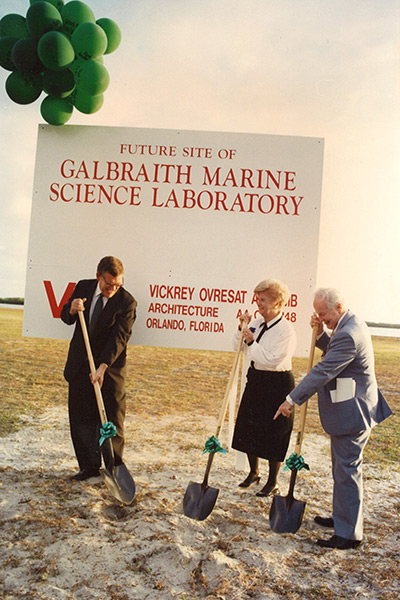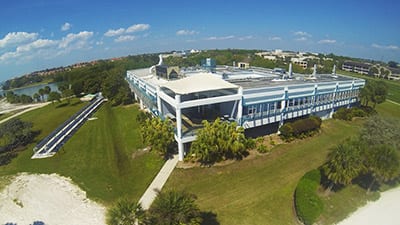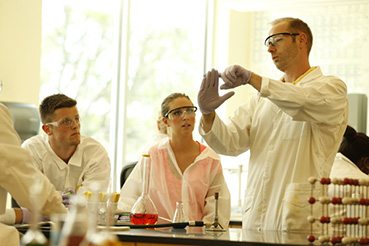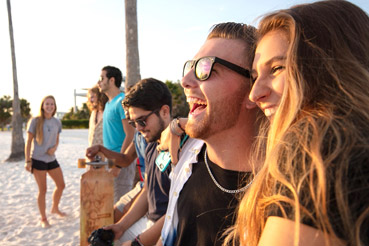The mission of Eckerd College is to provide excellent, innovative undergraduate liberal arts education and lifelong learning programs in the unique Florida environment, within the context of a covenant relationship with the Presbyterian Church (USA).
Approved by the Board of Trustees
May 21, 2016
Eckerd History
Through the years
The history of Eckerd College is the story of a visionary church, a courageous Board of Trustees, a highly committed faculty and staff, adventurous students, and thousands of friends who turned an idea into a reality. Here are some of the highlights.
May 20, 1958
The Florida Synod of the Presbyterian Church, USA, votes to establish Florida Presbyterian College.
June 17, 1958
The Florida Legislature grants the charter for the Florida Presbyterian College, and the Presbyterian synods appoint a board of trustees.
Sept. 1958

The United Presbyterian Church and the Presbyterian Church together name William H. Kadel, Ph.D., the first president of Florida Presbyterian College.
April 22, 1959
William H. Kadel,, Congressman William Cramer of St. Petersburg, and Philip J. Lee (the first Chairman of the Board of Trustees) meet with President Dwight D. Eisenhower in Washington D.C. to enroll President Eisenhower as the first charter alumnus of Florida Presbyterian College.
Fall 1960
At the opening convocation of Florida Presbyterian College, the Honorable Leroy Collins, Governor of Florida from 1955-1961, gives a warm welcome and predicts a “long and outstanding career of service” for the college.
Sept. 6, 1960

The first day of classes is held, with 155 freshman and 22 faculty in temporary quarters on Bayboro Harbor in downtown St. Petersburg.
Nov. 1960

The Florida Presbyterian College Bulletin announces that, by vote of the Founding Freshman class, the college’s mascot would be the Triton, a mythological creature with the torso of a man and tail of a fish who calmed the seas with a conch-shell trumpet.
Dec. 14, 1960
The first issue of the student newspaper, The Trident, is released. The issue includes opinion columns about the proper way to launder clothing, the quality of the cafeteria’s food and how the size of the campus is not proportional to the dazzling school spirit the students possess. Also included: a reflection of the required course for all freshmen now known as “The Human Experience.”
Sept. 24, 1961

Groundbreaking ceremony held for the new campus along Boca Ciega Bay on the southern tip of St. Petersburg. The college received 186 shovels from colleges across the country, including Loyola University, Tulane, Yale, FSU, and the Georgia Institute of Technology. The shovels were a symbol of the unity of academia.
Dec. 29, 1961
The first Winter Term program takes 30 students to Mexico, led by Sociology Professor Clark Bouwman, a founding professor. The course was “An Introduction to the Fields of Anthropology and Archeology in Mexico.” The cost was $275.
June 1962
All but two faculty members submit their resignations to the Board of Trustees to protest decision not to admit first Black student. In October, the Board reverses position. That young student, Howard Kennedy, later becomes a member of the Board of Trustees.
September 1963
The first semester that all classes and students were located on the new campus along Boca Ciega Bay.
June 1, 1964
Commencement of the first graduating class takes place at Pasadena Community Church.
Nov. 30, 1966
Florida Presbyterian College receives full accreditation by the Southern Association of Colleges and Schools.
May 8, 1968
Billy O. Wireman, a founding faculty member, is named second president, the youngest college president in the country at that time.
September 1, 1968

Wireman Chapel (formerly Griffin Chapel) holds its first service with its purpose—as expressed in the first dedication service on March 9, 1969—to develop the spirit of love, understanding and forgiveness.
Sept. 15, 1970

Twenty-nine students stay at the London Study Centre, the cornerstone of the International Education Program.
June 1971
The two Presbyterian synods transfer full control of the college to a self-perpetuating board of trustees and affirms a covenant relationship between the college and the Church.
September 1971
FPC Search, Rescue and Safety Team (providing services to the public since 1977 as Eckerd College Search and Rescue), the only volunteer student rescue group recently recognized by the U.S. Coast Guard, is established.
October 20, 1971
Two dozen Black students hold a sit-in at Brown Hall to protest treatment of Black students on campus and to encourage greater diversity among students, faculty and staff.
August 27, 1973
The first day of classes for the first ever Autumn Term program, which was part of “Project ’73.” Project ’73 establishes the Autumn Term program, the Collegium structure, and the role of faculty members as mentors.
March 21, 1977
Board of Trustees Chairman Jack M. Eckerd named interim president.
July 1977
The Board of Trustees selects Peter H. Armacost to become Eckerd College’s third president.
November 30, 1977
The establishment of the Program for Experienced Learners is approved by the college’s faculty. First classes were offered in January 1978. The accredited program was open to degree-seeking adults and offered some college credit for documented life experience.
Fall 1980
The Leadership Development Institute is formed.
October 31, 1982
The Academy of Senior Professionals at Eckerd College is officially inaugurated with 14 charter members.
November 20, 1991

Groundbreaking of the Galbraith Marine Science Laboratory. Photo: Then-President Armacost (left) breaks ground with Rosemary and John Galbraith
April 15, 1993

Galbraith Marine Science Laboratory (GMSL) is dedicated, reinforcing the Marine Science major (established in 1982) as one of the finest and most unique in the country. The GMSL was made possible primarily by a gift of $2.9 million from John and Rosemary Galbraith.
June 30, 2000
Lloyd W. Chapin, faculty dean and vice president for academic affairs, is named acting president.
September 1, 2000
Eugene Hotchkiss III, President Emeritus of Lake Forest College, is named to a one-year term as interim president.
July 1, 2001
Donald R. Eastman III becomes the College’s fourth President.
December 10, 2002

Groundbreaking ceremony held for the Armacost Library took place on Tuesday, December 10, 2002. The site was thoughtfully chosen to place the library at the physical intersection of the academic and residential precincts of campus. The official dedication of the library was on Friday, February 18, 2005. The library houses a permanent art collection featuring representative works from the College’s founding visual arts faculty. The Thomas Dreier Grand Reading Room honors a St. Petersburg resident and philanthropist who made a very public contribution to the College in 1965 after Eckerd faculty participated in the civil rights march in Selma, Alabama.
August 9, 2003
The Phi Beta Kappa Society awards the Zeta Chapter of Florida to Eckerd College at the 40th Council.
January 22, 2005
Writers in Paradise annual conference is created by co-directors novelist Dennis Lehane ’88 and Professor Sterling Watson ’68.
January 21, 2013

Grand opening of the James Center for Molecular and Life Sciences
June 2015
James Center for Molecular and Life Sciences earns LEED Platinum designation.
October 27, 2016

Dedication ceremony held for the Doyle Sailing Center.
February 9, 2018

Grand opening held for The Helmar and Enole Nielsen Center for Visual Arts.
July 1, 2020
The “Eastman Era” ends; Damián J. Fernández becomes the College’s fifth president.
October 15, 2021
The Board of Trustees adopts a five-year strategic plan, “Onward: Strategy in Action 2021–2026.”
August 2, 2022
Vice President for Student Life and Dean of Students James J. Annarelli is named interim president.
February 10, 2023
Eckerd College trustees name James J. Annarelli the school’s sixth president.






